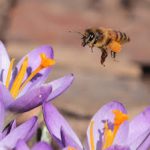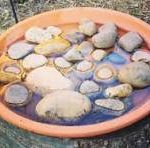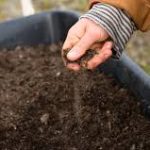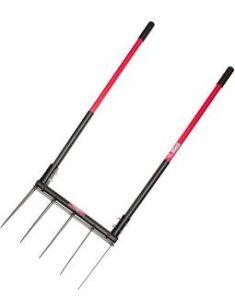How to Garden in Support of Pollinators
It’s important to realize that in addition to honeybees, bumblebees, native bees, butterflies, moths, flies and more also fill a role as pollinators in our landscapes and gardens. To attract the greatest diversity of pollinators, we need to supply a source of food, water, and shelter. 
The key to attracting and supporting pollinators is to offer plants that provide pollen and nectar through the season. This can be accomplished by includ-ing annuals and herbs in your garden, along with perennials and native plants.
Native plants include Columbine, Native Bee Balm, Rocky Mountain Penstemon and Sunset Hyssop. Perennials with good sources of nectar and pollen include Asters, Black-eyed Susan, Columbine, Coneflower, Digitalis, Gaillardia, Joe-pie Weed, Mums, Penstemon and Sedum.
 Annuals such as Sunflowers, Zinnias, Marigolds, Lantana, Petunias, and Salvia will help fill in any gaps in the seasonal bloom cycle. Pollinator-friendly shrubs in your garden include Blue Mist Spirea, Lilac, Rose of Sharon, Weigela and Butterfly Bushes.
Annuals such as Sunflowers, Zinnias, Marigolds, Lantana, Petunias, and Salvia will help fill in any gaps in the seasonal bloom cycle. Pollinator-friendly shrubs in your garden include Blue Mist Spirea, Lilac, Rose of Sharon, Weigela and Butterfly Bushes.
Beyond perennials, annuals and flowering shrubs, think about incorporating herbs such as chives, basil, comfrey, mint and lavender amongst your tomato and vegetable crops.
Cover crops such as Crimson Clover attract pollinators and can dug into your garden to improve the soil once it stops flowering.
In the fall, plant spring blooming bulbs such as crocus, hyacinths and tulips to support early foraging pollinators. 
Planting in groups or clusters will bring a focus to your landscape and save pollinator’s energy searching for food.
Gardening with pollinators in mind should include accessible water. This could be a shallow pot saucer or a birdbath. Place some flat stones in the birdbath or saucer so pollinators will have a place to land and drink safely. Consider leaving a patch of the garden uncultivated for bumble bees that burrow. For wood and stem-nesting. 
If you do not have a traditional garden space where you can plant directly in the ground, you can plant in containers and place them on your patio or deck. Select a few different kinds of plants of varying heights, colors and textures. Pollinators will find them.
Even a small pollinator garden will help support bees, butterflies and other pollinators. With some thought and planning, you can create a destination that pollinators will be attracted to. Michael Morris
Amending the Soil by Michael Morris
Now that you’ve done your soil tests, how do you turn your low organic, high clay soil into something you can really grow in? 
You supplement it with soil amendments. What is a soil amendment? Soil amendments are products which help add organic material to the soil. A good soil amendment will make your existing soil healthier and more fertile by improving the structure of the soil, which allows better, stronger root development. Stronger root systems mean healthier plants and better yields in your vegetable garden. Adding organic material also helps lower the soil ph. Soil pH is a measure of how “sweet” or “sour” our soils are. For most of us, our garden soils are alkaline (sweet) with high levels of ph. Plant production is optimized when grown in neutral or slightly acidic soils, because fertilizers and nutrients are more available when the soil pH is right.
When it comes to choosing soil amendments, it’s best to use Colorado-based products that are specifically designed to work in our clay-based soils.
This includes Earth Essentials Sheep, Peat and Compost which contains aged sheep manure, peat moss and compost, Cow and Compost, which consists of aged and screened dairy manure and Natures Yield Organic Compost which is EKO compost and sphagnum peat. If you’re growing in a raised bed, consider adding EKO Raised Bed mix. How many bags do you need? A bag of Sheep, peat and compost will cover 10 square feet, 2” deep.
Adding earthworm castings at this point will increase soil microbial activity and act as a mild fertilizer. A 30-pound bag will cover about 100 square feet, 1″ deep. Typically, you’ll want to add 1″ to 2″ of organic worm castings to your soil each season.
Take your bags home, open them up and put them in a pile. It’ll make it easier to mix all your ingredients together and will help break down surface tension, which reduces the resistance to water absorption.
So now we have this pile of amendments including a bag of Sheep, Peat and Compost and some earthworm castings and we’re going to dig it all in about 50:50 with our native soil. It’s important to include your native clay in the mix, because clay tends to be nutrients rich in calcium, potassium and magnesium. Amended clay also holds moisture well and doesn’t compact. Plan to amend your garden soil annually, spring and fall to keep it healthy and productive.
Soil Testing: How to test your garden soil by Michael Morris
Want to have a better, more productive garden this season? It all starts with a healthy soil? Now’s the time, before you start planting, to understand your soil, by testing two important elements: pH and structure. You can test your garden soil yourself and get reliable results. Here’s what you need:
A home soil test kit, such as Rapitest soil test kit
An empty Mason jar or peanut butter jar
A scoop for gathering soil
Garden gloves
Soil pH is a measure of the acidity or alkalinity of a soil. On the pH scale, 7.0 is neutral, above 7 is alkaline, below 7 is acidic. Most plants prefer a pH of between 6.5 and 7. Our soil is typically greater than 7. High pH locks out the nutrients that your plants need.
Rapitest offers a 10-test soil pH test kit. All you do is take a sample of soil, mix with water, transfer some of the solution to the color comparator, add powder from capsule, shake and watch the color develop. Then, note your test results. Fast, easy and it only takes a few minutes.
In addition to pH, the structure, physical makeup, and organic content of your soil has a direct impact on your garden’s productivity. Whether you’re growing in a raised bed or an in-ground one, the physical quality of the soil affects everything from strong root development to flower and fruit production.
The Jar Test is a quick, easy way to help you determine the structure and physical makeup of your soil. You’ll need a clean jar with a lid, in this case a peanut butter container. Put 4-5 ounces of soil in the bottom of the jar. Add enough water to fill the jar 2/3 full. Add a drop or two of dishwasher soap. Put the lid on and shake well, then let the jar sit undisturbed for 24 hours. You’ll see that the soil has settled into layers. The first layer will be sand. The second layer will be silt, followed by clay, suspended clay, then a small amount of organic material, floating at the top. 
To achieve a better ratio of organic material to clay, as well as balance soil pH, plan to add two to three inches of organic compost and coconut coir to your garden in the spring and again in the fall. Worm casting are also good choices for improving your garden soil.
Incorporating these products on a continuing basis will improve soil structure, lower pH as well as feed and diversify your soil microbiome.
If you’re looking for a more comprehensive evaluation of your soil, Colorado State University also offers soil testing. Follow this link to learn how take and submit a sample for analysis: https://agsci.colostate.edu/
A Timeline for Starting Seeds Indoors by Michael Morris
When it comes to starting seeds indoors in the spring, knowing when to start is one of the most important elements. Begin by understanding the hardiness zone you garden in. Sometimes called growing zones, USDA zone hardiness maps are based on winter temperature averages over a thirty-year period. The intent is to help gardeners make informed decisions regarding which plants will perform well in their geographical area. While primarily aimed at trees, shrubs, perennials, knowing your hardiness zone is useful for your vegetable garden as well. The 5 zones represented in Colorado are 3, 4, 5, 6, 7. The mountains are predominantly Zone 4, the fruit growing area near Grand Junction is 6-7and the Front Range predominantly Zone 4-5. Longmont Plant Hardiness Zone is 5b and Estes Park is Zone 5a.
In Longmont, a normal growing season is 146 days (about 5 months). This number assumes that season extenders such as frost cloths, cloches or cold frames are not used. As a rule, May 15 (May 30 if you garden at altitude) is the start of our frost-free growing season. That said, you should always be prepared to deal with the unpredictable spring weather _some years we have been able to plant as early as Mothers’ Day, other seasons its after Memorial Day. October 1st is the average first Fall frost.
Using May 15 and the information on the back of the seed packets you’ve selected will determine the day you’ll want to start your seeds indoors. Example: Peppers and tomatoes should be started eight to ten weeks before last spring frost. If you calculate ten weeks before May 15, seeds for these warm weather crops should be started the week of March 7.
Cool weather crops (lettuce, spinach, kale) and root crops (carrots, radishes, turnips) respond best to direct sowing in the garden. They typically don’t transplant well.
Begin the process by choosing high quality, fresh seeds from local suppliers. Check the back of the seed packet. There should be a 2025 date printed on it. This is your assurance that the seed is fresh. When you open the seed packet you should find seeds that are uniform in size and color. Selecting fresh, premium seeds will give you better germination rates and stronger seedlings, which ultimately leads to a better crop.
Take time to read the seed packet. You’ll fine valuable information regarding planting depth, spacing and days to germination as well as days to maturity, once your transplants are in the ground.
Gardening with a Broadfork by Dudley McBride
Several years ago I was turning the soil in my raised beds with a shovel and thought there had to be an easier way. Plus, Iwanted a tool that supported a no-till approach to soil management. After some research, I purchased a broadfork from Mountain Creature (https://meadowcreature.com). So what is a broadfork and why do some gardeners speak so favorably of its use in their gardens?
A broadfork is like a tall pitchfork EXCEPT it has two long handles – one on each side of a 1-2 ft. metal crossbar from which several long tines extend down towards the ground. When the gardener steps on the broadfork’s crossbar with her full weight while holding the overhead handles, and then steps backwards pulling the handles towards herself and then forward again, the forks loosen the soil, but don’t turn over the soil. Thereby, the layers of soil are left intact yet aerated, inviting air & water. The broadfork seems to have been invented by Andre Grelinin in the 1960’s. It was known as a grenlinette in France and was introduced into the United States in the early 1990’s by Eliot Coleman, author of New Organic Grower and other works. Coleman has quite an extensive farming and advisory backgroundin the field of organic gardening.
Many gardeners like using the broadfork for various reasons. Forone, it’s easier than digging down with a shovel, lifting a load of dirt, and turning it over. Lifting that dirt seems to get heavier & heavier. In addition, when shoveling or even tilling soil, the dormant weeds under the surface are brought up to the top where they can germinate and flourish for another season. With the broadfork, the dormant weed seeds remain underneath. In addition, with a broadfork one can loosen the soil without destroying the soil structure and the living web of bacteria, fungi, and earthworms beneath the soil surface, which are good for healthy garden soil.
Broadforks come in a variety of dimensions and constructions. My broadfork is made of steel which makes it heavier than broadforks with wooden or fiberglass handles. Weight and handle length relation to the user’s size and strength should be taken into consideration when choosing a broadfork.





